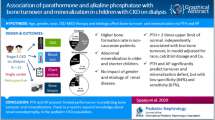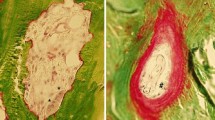Abstract
Bone and mineral metabolism abnormalities are frequent in kidney transplant recipients and have been associated with cardiovascular morbidity. The primary aim of this study was to analyse the association between routine clinically available biochemical evaluation, non-routine histomorphometric bone evaluation, and vascular disease in kidney transplanted patients. A cross-sectional analysis was performed on 69 patients, 1-year after kidney transplantation. Laboratory analysis, radiography of hands and pelvis, bone biopsy, bone densitometry, and coronary CT were performed. One-year post-transplantation, nearly one-third of the patients presented with hypercalcemia, 16% had hypophosphatemia, 39.3% had iPTH levels > 150 pg/mL, 20.3% had BALP levels > 40 U/L, and 26.1% had hypovitaminosis D. Evaluation of extraosseous calcifications revealed low Adragão and Agatston scores. We divided patients into three clusters, according to laboratory results routinely used in clinical practice: hypercalcemia and hyperparathyroidism (Cluster1); hypercalcemia and high BALP levels (Cluster2); hypophosphatemia and vitamin D deficiency (Cluster 3). Patients in clusters 1 and 2 had higher cortical porosity (p = 0.001) and osteoid measurements, although there was no difference in the presence of abnormal mineralization, or low volume. Patients in cluster 2 had a higher BFR/BS (half of the patients in cluster 2 had high bone turnover), and most patients in cluster 1 had low or normal bone turnover. Cluster 3 has no differences in volume, or turnover, but 60% of the patients presented with pre-osteomalacia. All three clusters were associated with high vascular calcifications scores. Vascular calcifications scores were not related to higher bone mineral density. Instead, an association was found between a higher Adragão score and the presence of osteoporosis at the femoral neck (p = 0.008). In conclusion, inferring bone TMV by daily clinical biochemical analysis can be misleading, and bone biopsy is important for assessing both bone turnover and mineralization after kidney transplantation, although hypophosphatemia combined with vitamin D deficiency is associated with abnormal mineralization. The presence of hypercalcemia with high levels of PTH or high levels of BALP, or hypophosphatemia and vitamin D deficiency should remind us to screen vascular calcification status of patients.
Clinical Research: ClinicalTrials.gov ID NCT02751099.

Similar content being viewed by others
Data Availability
The results presented in this paper have not been published previously in whole or part, except in the abstract format. The data supporting the findings of this study are available upon reasonable request from the corresponding author. The data were not publicly available because of privacy or ethical restrictions.
References
Jørgensen H, Behets G, Bammens B, Claes K, Meijers B, Naesens M et al (2022) Natural history of bone disease following kidney transplantation. J Am Soc Nephrol. https://doi.org/10.1681/asn.2021081081
Evenepoel P, Behets GJ, Viaene L, D’Haese PC (2017) Bone histomorphometry in de novo renal transplant recipients indicates a further decline in bone resorption 1 year posttransplantation. Kidney Int 91(2):469–476. https://doi.org/10.1016/j.kint.2016.10.008
Keronen S, Martola L, Finne P, Burton IS, Kroger H, Honkanen E (2019) Changes in bone histomorphometry after kidney transplantation. Clin J Am Soc Nephrol 14(6):894–903. https://doi.org/10.2215/CJN.09950818
Marques IDB, Araujo M, Graciolli FG, Dos Reis LM, Pereira RMR, Alvarenga JC et al (2019) A Randomized trial of zoledronic acid to prevent bone loss in the first year after kidney transplantation. J Am Soc Nephrol 30(2):355–365. https://doi.org/10.1681/ASN.2018060656.PubMedPMID:30606784;PubMedCentralPMCID:PMCPMC6362629
Ferreira AC, Mendes M, Silva C, Cotovio P, Aires I, Navarro D et al (2022) Improvement of mineral and bone disorders after renal transplantation. Transplantation 106(5):e251–e261. https://doi.org/10.1097/tp.0000000000004099
Torregrosa J-V, Ferreira AC, Cucchiari D, Ferreira A (2021) Bone mineral disease after kidney transplantation. Calcif Tissue Int. https://doi.org/10.1007/s00223-021-00837-0
Ferreira AC, Cohen-Solal M, D’Haese PC, Ferreira A (2021) The role of bone biopsy in the management of CKD-MBD. Calcif Tissue Int 108(4):528–538. https://doi.org/10.1007/s00223-021-00838-z
Evenepoel P, D’Haese P, Bacchetta J, Cannata-Andia J, Ferreira A, Haarhaus M et al (2017) Bone biopsy practice patterns across Europe: the European renal osteodystrophy initiative-a position paper. Nephrol Dial Transplant 32(10):1608–1613. https://doi.org/10.1093/ndt/gfw468
Fusaro M, Re Sartò GV, Gallieni M, Cosmai L, Messa P, Rossini M et al (2022) Time for revival of bone biopsy with histomorphometric analysis in chronic kidney disease (CKD): moving from skepticism to pragmatism. Nutrients. https://doi.org/10.3390/nu14091742
Cohen-Solal M, Funck-Brentano T, Ureña TP (2020) Bone fragility in patients with chronic kidney disease. Endocr Connect 9(4):R93–R101. https://doi.org/10.1530/ec-20-0039
Toussaint ND, Lau KK, Strauss BJ, Polkinghorne KR, Kerr PG (2007) Associations between vascular calcification, arterial stiffness and bone mineral density in chronic kidney disease. Nephrol Dial Transplant 23(2):586–593. https://doi.org/10.1093/ndt/gfm660
von Elm E, Altman DG, Egger M, Pocock SJ, Gøtzsche PC, Vandenbroucke JP (2008) The Strengthening the Reporting of Observational Studies in Epidemiology (STROBE) statement: guidelines for reporting observational studies. J Clin Epidemiol 61(4):344–349. https://doi.org/10.1016/j.jclinepi.2007.11.008
Matias P, Ávila G, Ferreira AC, Laranjinha I, Ferreira A (2023) Hypomagnesemia: a potential underlooked cause of persistent vitamin D deficiency in chronic kidney disease. Clin Kidney J. https://doi.org/10.1093/ckj/sfad123
Espuch-Oliver A, Vázquez-Lorente H, Jurado-Fasoli L, de Haro-Muñoz T, Díaz-Alberola I, López-Velez MDS et al (2022) References values of soluble α-klotho serum levels using an enzyme-linked immunosorbent assay in healthy adults aged 18–85 years. J Clin Med. https://doi.org/10.3390/jcm11092415
Heijboer AC, Cavalier E (2023) The measurement and interpretation of fibroblast growth factor 23 (FGF23) concentrations. Calcif Tissue Int 112(2):258–270. https://doi.org/10.1007/s00223-022-00987-9
Adragao T, Pires A, Lucas C, Birne R, Magalhaes L, Goncalves M et al (2004) A simple vascular calcification score predicts cardiovascular risk in haemodialysis patients. Nephrol Dial Transplant 19(6):1480–1488. https://doi.org/10.1093/ndt/gfh217
Agatston AS, Janowitz WR, Hildner FJ, Zusmer NR, Viamonte M Jr, Detrano R (1990) Quantification of coronary artery calcium using ultrafast computed tomography. J Am Coll Cardiol 15(4):827–832
Malluche HH, Mawad HW, Monier-Faugere MC (2011) Renal osteodystrophy in the first decade of the new millennium: analysis of 630 bone biopsies in black and white patients. J Bone Miner Res 26(6):1368–1376. https://doi.org/10.1002/jbmr.309
Salam S, Gallagher O, Hughes D, Khwaja A, Eastell R (2021) The role of static bone histomorphometry in diagnosing renal osteodystrophy. Bone 142:115689. https://doi.org/10.1016/j.bone.2020.115689
Dempster DW, Compston JE, Drezner MK, Glorieux FH, Kanis JA, Malluche H et al (2013) Standardized nomenclature, symbols, and units for bone histomorphometry: a 2012 update of the report of the ASBMR Histomorphometry Nomenclature Committee. J Bone Miner Res 28(1):2–17. https://doi.org/10.1002/jbmr.1805
Bhan A, Qiu S, Rao SD (2018) Bone histomorphometry in the evaluation of osteomalacia. Bone Rep 8:125–134. https://doi.org/10.1016/j.bonr.2018.03.005
Borchhardt K, Sulzbacher I, Benesch T, Fodinger M, Sunder-Plassmann G, Haas M (2007) Low-turnover bone disease in hypercalcemic hyperparathyroidism after kidney transplantation. Am J Transplant 7(11):2515–2521. https://doi.org/10.1111/j.1600-6143.2007.01950.x
Keronen SM, Martola LAL, Finne P, Burton IS, Tong XF, Kröger HP et al (2022) Clinical prediction of high-turnover bone disease after kidney transplantation. Calcif Tissue Int 110(3):324–333. https://doi.org/10.1007/s00223-021-00917-1
Pereira L, Magalhães J, Mendonça L, Neto R, Santos J, Carvalho CG et al (2022) Evaluation of renal osteodystrophy and serum bone-related biomarkers in a peritoneal dialysis population. J Bone Miner Res. https://doi.org/10.1002/jbmr.4636
Lecoq AL, Brandi ML, Linglart A, Kamenický P (2020) Management of X-linked hypophosphatemia in adults. Metabolism. https://doi.org/10.1016/j.metabol.2019.154049
Ferreira AC, Cotovio P, Aires I, Mendes M, Navarro D, Silva C et al (2022) The role of bone volume, FGF23 and sclerostin in calcifications and mortality; a cohort study in CKD stage 5 patients. Calcif Tissue Int 110(2):215–224. https://doi.org/10.1007/s00223-021-00910-8
Jørgensen HS, Borghs H, Heye S, Smout D, Claes K, Evenepoel P (2022) Vascular calcification of the abdominal aorta has minimal impact on lumbar spine bone density in patients with chronic kidney disease. Bone 162:116482. https://doi.org/10.1016/j.bone.2022.116482
Kauppila LI, Polak JF, Cupples LA, Hannan MT, Kiel DP, Wilson PW (1997) New indices to classify location, severity and progression of calcific lesions in the abdominal aorta: a 25-year follow-up study. Atherosclerosis 132(2):245–250. https://doi.org/10.1016/s0021-9150(97)00106-8
Sotomayor CG, Benjamens S, Gomes-Neto AW, Pol RA, Groothof D, Te Velde-Keyzer CA et al (2021) Bone mineral density and aortic calcification: evidence for a bone-vascular axis after kidney transplantation. Transplantation 105(1):231–239. https://doi.org/10.1097/tp.0000000000003226
Evenepoel P, Opdebeeck B, David K, D’Haese PC (2019) Bone-vascular axis in chronic kidney disease. Adv Chronic Kidney Dis 26(6):472–483. https://doi.org/10.1053/j.ackd.2019.09.006
Fusaro M, Schileo E, Crimi G, Aghi A, Bazzocchi A, Barbanti Brodano G et al (2022) A Novel quantitative computer-assisted score can improve repeatability in the estimate of vascular calcifications at the abdominal aorta. Nutrients. https://doi.org/10.3390/nu14204276
Acknowledgements
We thank CHULC for their assistance with this study. We thank the Portuguese Society of Nephrology and Portuguese Society of Transplantation/Astellas for awarding us a research grant. We would like to thank Sandra Silva for help with administrative work, and Dr. Isabel Mesquita for help with sample storage and handling. We thank the Radiology Department of Hospital Santa Marta and Hospital Santo António dos Capuchos from CHULC for performing the CT scans and DXA examinations, respectively. We thank the patients for their consent to participate in this study.
Funding
This study was supported by a grant from the Portuguese Society of Nephrology and the Portuguese Society of Transplantation/Astellas.
Author information
Authors and Affiliations
Contributions
ACF and AF: conceptualized and designed the study. ACF, MM, CS, PC, IA, DN, FC, RS, BC, and GC: collected data or performed bone biopsies or laboratory evaluations. ACF, MM, RS, BC, GC, FN, and AF: analyzed the data. ACF: drafted the article. MM, CS, PC, IA, DN, FC, RS, BC, GC, FN, and AF: revised the paper. All authors approved the final version of the paper and agreed with all aspects of the work.
Corresponding author
Ethics declarations
Conflict of interest
Besides receiving a grant from the Portuguese Society of Nephrology and Portuguese Society of Transplantation/Astellas. Ana Carina Ferreira, Marco Mendes, Cecília Silva, Patrícia Cotovio, Inês Aires, David Navarro, Fernando Caeiro, Rute Salvador, Bruna Correia, Guadalupe Cabral, Fernando Nolasco and Aníbal Ferreira have no conflicts of interest related to the present manuscript.
Human and Animal Rights and Informed Consent
The study was approved by the Institutional Local Ethics Committee and was performed in accordance with the ethical standards as laid down in the 1964 Declaration of Helsinki and its later amendments. Informed consent was obtained from all patients at inclusion.
Additional information
Publisher's Note
Springer Nature remains neutral with regard to jurisdictional claims in published maps and institutional affiliations.
Rights and permissions
Springer Nature or its licensor (e.g. a society or other partner) holds exclusive rights to this article under a publishing agreement with the author(s) or other rightsholder(s); author self-archiving of the accepted manuscript version of this article is solely governed by the terms of such publishing agreement and applicable law.
About this article
Cite this article
Ferreira, A.C., Mendes, M., Silva, C. et al. Biochemical Clusters as Substitutes of Bone Biopsies in Kidney Transplant Patients. Calcif Tissue Int 114, 267–275 (2024). https://doi.org/10.1007/s00223-023-01173-1
Received:
Accepted:
Published:
Issue Date:
DOI: https://doi.org/10.1007/s00223-023-01173-1




